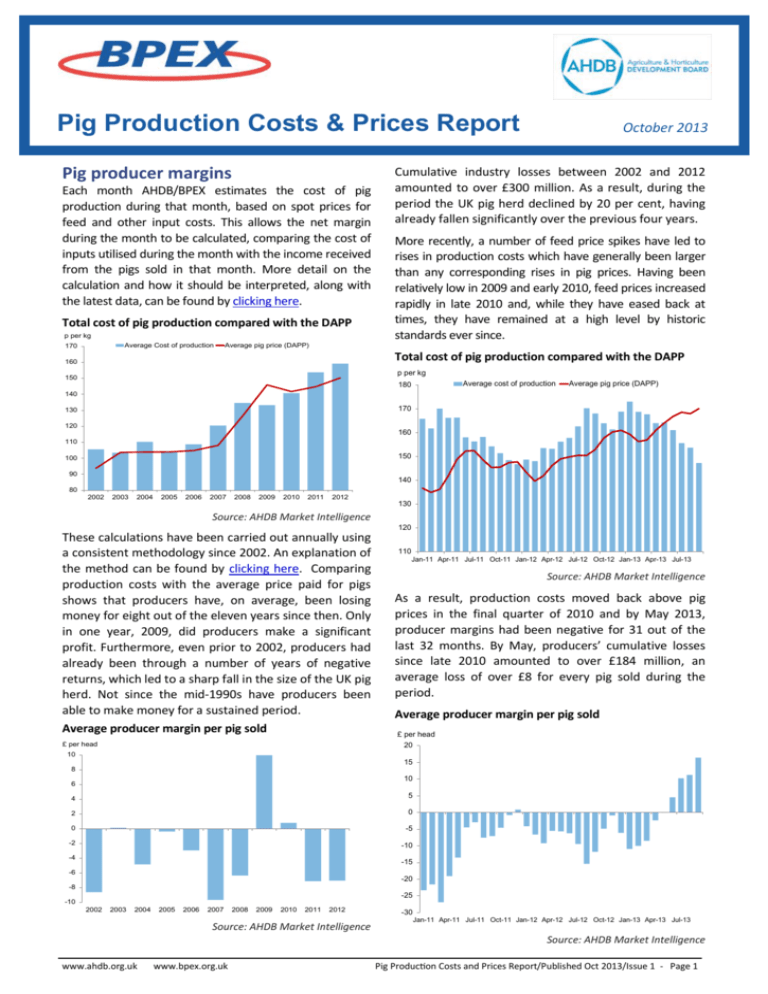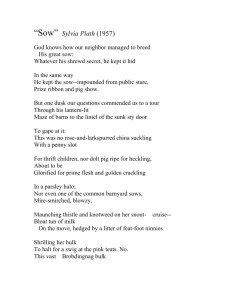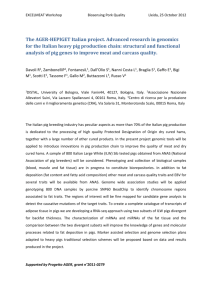
Pig Production Costs & Prices Report
Pig producer margins
Each month AHDB/BPEX estimates the cost of pig
production during that month, based on spot prices for
feed and other input costs. This allows the net margin
during the month to be calculated, comparing the cost of
inputs utilised during the month with the income received
from the pigs sold in that month. More detail on the
calculation and how it should be interpreted, along with
the latest data, can be found by clicking here.
Total cost of pig production compared with the DAPP
p per kg
Average Cost of production
170
October 2013
Cumulative industry losses between 2002 and 2012
amounted to over £300 million. As a result, during the
period the UK pig herd declined by 20 per cent, having
already fallen significantly over the previous four years.
More recently, a number of feed price spikes have led to
rises in production costs which have generally been larger
than any corresponding rises in pig prices. Having been
relatively low in 2009 and early 2010, feed prices increased
rapidly in late 2010 and, while they have eased back at
times, they have remained at a high level by historic
standards ever since.
Average pig price (DAPP)
Total cost of pig production compared with the DAPP
160
p per kg
150
Average cost of production
180
Average pig price (DAPP)
140
170
130
120
160
110
150
100
90
140
80
2002
2003
2004
2005
2006
2007
2008
2009
2010
2011
2012
130
Source: AHDB Market Intelligence
120
These calculations have been carried out annually using
a consistent methodology since 2002. An explanation of
the method can be found by clicking here. Comparing
production costs with the average price paid for pigs
shows that producers have, on average, been losing
money for eight out of the eleven years since then. Only
in one year, 2009, did producers make a significant
profit. Furthermore, even prior to 2002, producers had
already been through a number of years of negative
returns, which led to a sharp fall in the size of the UK pig
herd. Not since the mid-1990s have producers been
able to make money for a sustained period.
Average producer margin per pig sold
£ per head
110
Jan-11 Apr-11 Jul-11 Oct-11 Jan-12 Apr-12 Jul-12 Oct-12 Jan-13 Apr-13 Jul-13
Source: AHDB Market Intelligence
As a result, production costs moved back above pig
prices in the final quarter of 2010 and by May 2013,
producer margins had been negative for 31 out of the
last 32 months. By May, producers’ cumulative losses
since late 2010 amounted to over £184 million, an
average loss of over £8 for every pig sold during the
period.
Average producer margin per pig sold
£ per head
20
10
15
8
10
6
4
5
2
0
0
-5
-2
-10
-4
-15
-6
-20
-8
-25
-10
2002
2003
2004
2005
2006
2007
2008
2009
2010
2011
2012
Source: AHDB Market Intelligence
-30
Jan-11 Apr-11 Jul-11 Oct-11 Jan-12 Apr-12 Jul-12 Oct-12 Jan-13 Apr-13 Jul-13
Source: AHDB Market Intelligence
www.ahdb.org.uk
www.bpex.org.uk
Pig Production Costs and Prices Report/Published Oct 2013/Issue 1 - Page 1
Since June, producers have, on average, returned to a
profitable situation. While this has allowed them to
start recouping some of the losses made in the
preceding three years, cumulative industry losses since
the start of 2011 still amount to over £140 million.
prices during the life cycle of the pig gives the estimates
in the table below for recent months.
On the basis of these revised calculations, producers
are, on average, now getting a higher price for their pigs
then they cost to produce. However, the margins are
much smaller than indicated by the monthly cost of
production estimate. Therefore, any significant fall in
the pig price would mean that producers would again
be selling pigs at a loss. It is worth remembering that
until autumn 2012, the average finished pig price had
never been above 156p per kg. A return to that level
would mean that producers were still selling pigs at a
loss.
Cumulative pig producer losses since start of 2011
£200,000,000
£180,000,000
£160,000,000
£140,000,000
£120,000,000
£100,000,000
£80,000,000
Total cost of pig production compared with the DAPP
£60,000,000
p per kg
Published cost of production
180
£40,000,000
Lifetime cost of production
Average pig price (DAPP)
£20,000,000
170
£0
Jan-11 Apr-11 Jul-11 Oct-11 Jan-12 Apr-12 Jul-12 Oct-12 Jan-13 Apr-13 Jul-13
160
Source: AHDB Market Intelligence
150
Lifetime production costs
140
Based on the production cost calculations presented
above, producers returned to profit in June 2013 as feed
prices eased in anticipation of a much improved
Northern Hemisphere harvest this year. However, while
this reflects the operating position of many producers
during the month, it is not the whole story. In reality, it
will be some time before producers return to a more
comfortable position, never mind making significant
progress towards recovering the losses experienced in
recent years.
130
120
110
Jan-12 Mar-12 May-12 Jul-12 Sep-12 Nov-12 Jan-13 Mar-13 May-13 Jul-13 Sep-13
Source: AHDB Market Intelligence
Based on forward quotes for pig feed, lifetime
production costs are not likely to reach the level of the
current published cost of production until around
March 2014. This assumes that feed prices remain close
to the level they had reached recently. However, it is
worth noting that in the last two weeks, global and UK
wheat prices have started to increase, which could lead
to production costs starting to rise again.
One of the main reasons for this is that the published
cost of production estimates do not reflect the cost of
producing the pigs which are sold in the month. Pigs sold
in any given month will typically have been born around
five to six months earlier. Their mother will have been
served just under four months before that. Therefore,
the cost of producing each pig will depend on feed
prices during most of the preceding year, not just in the
month when they were sold.
Relationship with pig prices
Although pig prices have generally been on an upward
trend since the start of 2012, it would be incorrect to
think that this was primarily due to the rise in
production costs. Pig prices, like most market prices, are
largely a function of supply and demand. To some
extent, expectations about future levels of supply may
Precise estimates of the cost of producing pigs sold in a
given month are not available. However, adjusting the
feed component to take account of the variation in spot
Month
Published cost of
production (p/kg)
Published net
margin (£/pig)
Lifecycle cost of
production (p/kg)
Difference
(p/kg)
Lifecycle net
margin (£/pig)
May 2013
164.2
-0.11
165.9
+1.7
-1.41
June 2013
161.0
+4.53
164.8
+3.8
+1.54
July 2013
155.6
+10.19
162.7
+7.1
+4.59
August 2013
153.7
+11.23
159.9
+6.2
+6.32
September 2013
147.2
+16.40
157.3
+10.0
+8.49
Source: AHDB Market Intelligence
www.ahdb.org.uk
www.bpex.org.uk
Pig Production Costs and Prices Report/Published Oct 2013/Issue 1 - Page 2
contribute to pricing levels but, given that pork is a
perishable product, the effect of this on prices is likely
to be limited.
UK finished pig supplies in 2012 were generally slightly
more plentiful than in 2011. This suggests that higher
prices were largely due to increased demand for British
pigs. In turn, this can probably be mainly attributed to
higher EU prices, reducing competition from lowerpriced imported pork to some extent. This was
particularly apparent in the second half of 2012, when
UK pig prices bucked the usual seasonal trend by
increasing steadily, following similar rises on the
continent.
Comparison of UK and EU pig reference price
p/kg dw
170
UK
160
155
150
145
140
135
130
125
Jul-12
Supply chain margins
The volatility in both pig and feed prices in recent
times presents challenges for all of the players in the
supply chain. High raw material costs, for pigs or
feed, are being met with consumer resistance to
retail price increases as spending is still being
impacted by the austere economic climate. In this
climate, it has proved difficult to maintain
sustainable margins for producers, processors and
retailers.
Between September 2012 and September 2013,
average pig prices increased by just under 20p per
kg. Over the same period, retail pork prices
increased by a similar amount (when averaged over
the whole carcase). This means that producers are
now receiving a higher proportion of the retail price;
at around 43 per cent, their share is the highest since
the mid-1990s. Despite this, pork producers'
share remains well below that received by beef and
lamb producers, who typically receive over half the
retail price.
EU-27
165
120
Jan-12
close to 100% British. The stable supply situation does
mean that, as a result, some other retailers have been
unable to source the same quantity of British pork,
despite a stated desire to do so.
Jan-13
Jul-13
Source: AHDB Market Intelligence, EU Commission
EU prices have remained relatively firm throughout
most of 2013 and have played a part in UK prices
remaining high. Exchange rates have also contributed,
with the pound weaker against the euro, increasing
import prices in sterling terms. However, another
significant factor in pricing has been an increased
retailer preference for UK pig meat. This comes as they
seek shorter and more transparent supply chains in the
wake of the horse meat revelations earlier in the year.
During 2013, supplies have also been relatively tight,
with finished pig numbers close to their level in 2012. In
part, this is the result of the high production costs in
2012, which led to a reduction in the breeding herd as
some producers chose to leave the industry. This
demonstrates that production costs can have an
indirect (and delayed) impact on pig prices. However,
there is no reason why the fall in production costs in
recent months will automatically lead to lower pig
prices as the supply-demand balance has not changed.
Prices may come down in the longer-term if the more
favourable financial position leads to some expansion of
pig production.
The increased demand for British pork is apparent from
the latest results of BPEX’s Porkwatch survey. These
show notable increases in the British share of fresh pork
facings in some supermarkets, with several now at or
Comparison of pig and retail prices
p/kg
450
68%
Retailer/processor margin
DAPP
Retail carcase price
400
66%
350
64%
300
62%
250
60%
200
58%
150
56%
100
54%
50
0
2004
52%
2005
2006
2007
2008
2009
2010
2011
2012
2013
Source: AHDB Market Intelligence
Over the longer-term, retail pork prices have
increased as pig prices have risen. However, in
recent years, retail inflation has been lower than for
pig prices. As a result, margins in the supply chain
have gradually been eroded. Over the last year,
retailers and processors have received less than 60
per cent of the final retail price between them, down
from around 65 per cent five years ago. Given that
both processing and retailing involve significant
additional costs, beyond the purchase of the pigs,
this will have reduced profit margins even more
significantly.
© Agriculture and Horticulture Development Board 2012. All rights reserved. While the Agriculture and Horticulture Development Board, operating
through its BPEX division, seeks to ensure that the information contained within this document is accurate at the time of printing, no warranty is given
in respect thereof and, to the maximum extent permitted by law, the Agriculture and Horticulture Development Board accepts no liability for loss,
www.ahdb.org.uk
www.bpex.org.uk
Pig Production Costs and Prices Report/Published Oct 2013/Issue 1 - Page 3
damage or injury howsoever caused (including that caused by negligence) or suffered directly or indirectly in relation to information and opinions
contained in or omitted from this document.







